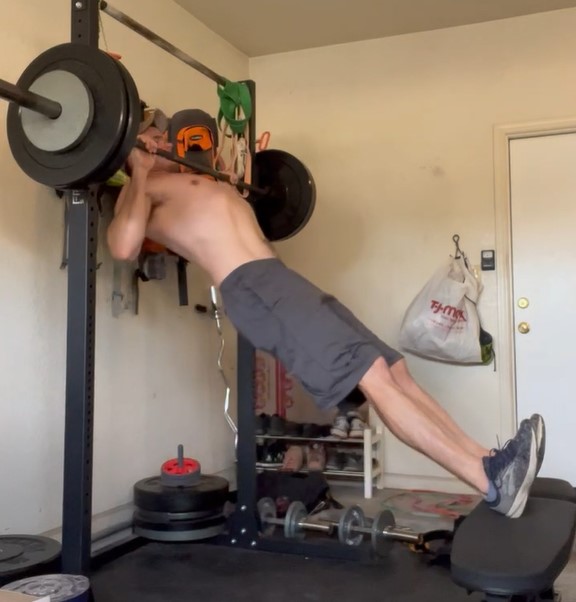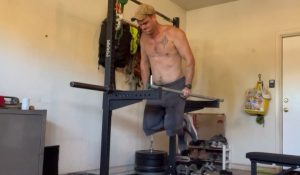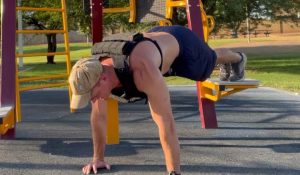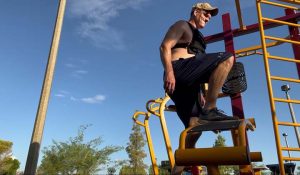As a person who’s fond of finding creative ways to crank out sets of basic calisthenics for muscle growth, I’ve been experimenting with some of the lesser-known forms of pull-ups and push-ups for the last few years. One of the best I’ve found is a criminally underrated compound back exercise, the jackknife pull-up.
Jackknife pull-ups differ from regular pull-ups in that they are performed with the feet placed on a bench or chair, relieving much of the resistance of a traditional pull-up and also changing the angle of pull slightly. This necessitates lowering the bar or rings from a traditional pull-up height to around clavicle height.
Though I have alluded to the usefulness of this overlooked exercise elsewhere, until now, I haven’t written an entire article explaining this excellent exercise. That’s about to change.
The 4 main benefits of jackknife pull-ups
Like any exercise, the jackknife pull-up should serve a specific function within a program. I’ve found that jackknife pull-ups have three main advantages over more traditional forms of pull-ups and rows:
Greater range of motion in the lats and rear delts
This benefit may not be obvious until the first time you try jackknife pull-ups. The jackknife pull-up actually takes the lats and rear delts through a greater range of motion than a traditional pull-up, since the changing body angle causes the exercise to be a hybrid of a vertical and horizontal pull. This is because the exercise ends up feeling like a hybrid between a pull-up and row:
In the bottom position, the lats are fully stretched and the arms are fully extended like in a traditional pull-up or chin-up:

In the top position, the elbows actually extend behind the torso, more like a row:

This means that in the top position, we’re getting a better contraction of the lats, rear delts, and mid/lower traps than in a traditional pull-up. While the resistance is certainly lighter, the range of motion is actually increased, meaning that this exercise could theoretically be considered better for hypertrophy than normal pull-ups and chin-ups.
They are better than inverted rows at improving pull-up strength
I’ve written elsewhere on the site about how I believe jackknife pull-ups are a much better way to improve pull-up strength than using inverted rows.
For individuals who struggle to get more than one or two pull-ups per set, this exercise will allow them to complete the necessary number of reps in a range of motion that has far more carryover to the traditional pull-up. It’s also a great stand-in exercise for people who are struggling to get their very first pull-up.
While I still believe the inverted row is a fantastic exercise, I tend to steer people towards the jackknife pull-up if they’re trying to get their first pull-up or take their pull-ups into the 5-8 range.
High potential for a great mind-muscle connection
Though the mind-muscle connection is a skill in and of itself, I’ve found that the jackknife pull-up lends itself to a great mind-muscle connection with the muscle groups being worked. The technique itself is simpler, since we’re not having to “control the swing” of a traditional pull-up or chin-up, and the resistance is lighter.
If you’ve never tried it, think of it like this:
Compare the feeling of your 3RM on bench press to the feeling of taking your 15RM for multiple sets close to failure. While the heavier weight will certainly lead to greater strength adaptations, the lighter weight lends itself to a greater mind-muscle connection and has a potentially greater hypertrophic benefit as a result.
Jackknife pull-ups are the same way: less resistance and extraneous movement (from the swing) allows us to focus on feeling the muscle contract and stretch as we complete reps.
Jackknife pull-ups are great for accumulating volume
Since this exercise is utilizing quite a bit less resistance, and there’s less to focus on technique-wise, the jackknife pull-up is a fantastic way to accumulate a lot of volume very quickly, while maintaining a better mind-muscle connection with the lats, traps, and rear delts. This additional volume makes the exercise fantastic for use as an assistance / hypertrophy exercise, or a great option to help with building pull-up strength.
How to do Jackknife Pull-ups
Jackknife pull-ups are performed by simply setting the bar or rings lower than you normally would for traditional pull-ups. Follow these steps to get the most out of the exercise:
Step 1: Set the bar or ring height. I’ve found that setting the bar or rings around the clavicle level is optimal. For reference, this tends to be around the bar height you would use for back or front squats.
Step 2: Set a box, bench, or chair in front of you at approximately the length of your legs. This should allow you to sit deep into the start position and feel a good stretch on the lats prior to initiating the movement. You may need to play with the positioning of the bar and box to achieve the desired position with legs straight (or a slight bend in your knees).
Step 3: Complete the desired number of repetitions, attempting to pull the bar into your sternum. This allows for the aforementioned greater range of motion, and creates a great contraction in the lats and rear delts.


Programming considerations for jackknife pull-ups
The jackknife pull-up or chin-up can be inserted into any existing program in place of a regular compound upper-body pulling exercise. If you don’t already have a program, I recommend starting with around 10 sets per week, close to failure, split between 2-3 sessions and working towards around 20 sets per week. For specific goals, here are some extra considerations:
For back strength, try starting the session off with three low-rep sets of normal pull-ups, chin-ups, or negative pull-ups. Rest around 3 minutes between sets. After the three “strength” sets, switch to jackknife pull-ups, completing three sets, close to failure, with a 1-2 minute rest period.
For hypertrophy, try completing around 5 sets of jackknife pull-ups, close to failure, focusing on the mind-muscle connection and using a full range of motion. If you’re getting more than around 12-15 reps per set, start off by using a weight vest or weight plate (across the lap) in order to add resistance and make the exercise tougher. Once your reps drop below around 8 reps per set, remove the weight and repeat the rest of your sets with just your body weight.
For time efficiency, try using jackknife pull-ups as an upper / lower superset with weighted vest squats. As mentioned earlier, the optimal bar height for jackknife pull-ups is (approximately) squat bar height in a rack. This leads to a perfect superset that shouldn’t interfere with your normal squat workout (since the exercises utilize completely different body parts).





















